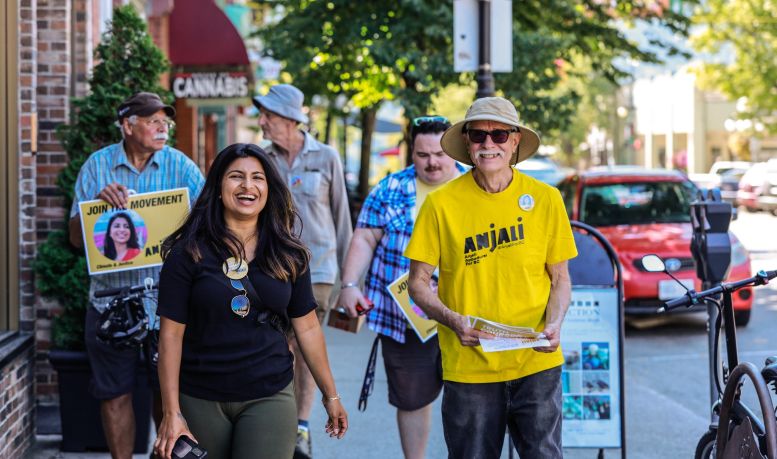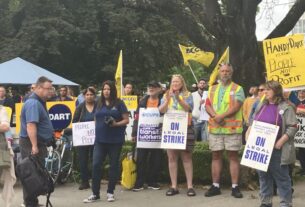The New Democratic Party (and its pre-1961 predecessor, the Co-operative Commonwealth Federation) was once a party with relatively healthy internal democracy and a relatively active membership. While never more than a social-democratic party, it kept its base engaged through riding association meetings, workplace activity through unions, and literal kitchen-table talks in big cities and small towns. The party’s bosses and policies were always well within the bounds of capitalist acceptability, but the leaders still permitted grassroots movements to develop, most notably that which led to Saskatchewan implementing public health care in 1962.
But the party has also been sure to always keep its more socialist wing within bounds and has never shied away from bureaucratic and anti-democratic measures to do so. These were most famously deployed in the party establishment’s destruction of the left-nationalist Waffle movement of 1969–74. It was on display again in the federal party conventions of 2011 and 2013, which resulted in the word “socialism” being removed from the party’s constitution.
The leadership is now politically well to the right of where it was in past decades, and its bureaucracy has now claimed another victim with the disqualification of climate activist and former federal NDP candidate Anjali Appadurai from the BC NDP leadership election. As a consequence, former attorney general David Eby has now been acclaimed as leader. At the end of a four-hour meeting on October 19, at about 10 p.m., the BC NDP’s provincial executive voted to accept the recommendation of the party’s chief electoral officer Elizabeth Cull to not approve Appadurai’s official application to run in the race, leaving an open path for establishment candidate Eby to the top job. (Eby’s application had been rubber-stamped in the summer.) During that meeting, Appadurai was not even granted 10 minutes to speak on why she felt the allegations against her were biased and insufficient to force an end to her campaign. After a debate on that minor motion, which lasted four times as long as the allotment that was asked for, the executive voted to reject her request.
As Appadurai was Eby’s only challenger, a series of debates and a vote of party members scheduled to conclude on December 3 were avoided, and Eby was sworn in as premier to succeed the retiring John Horgan on October 21.
The official reason given by Cull for the disqualification was that Appadurai’s leadership campaign had improperly interacted with and accepted aid from the climate-focussed non-profit organization Dogwood BC, in the form of Dogwood executives taking positions on her campaign team and Dogwood encouraging its supporters to join the NDP and vote in the leadership race.
Why did they really do it?
In light of the party establishment’s attempts to befog the real issues, it must be stated plainly that Appadurai’s disqualification had nothing to do with “collusion,” improper aid from an outside organization, or a professed fear that environmentalists and Green Party members were attempting a hostile takeover of the NDP. The real issue is that the NDP bureaucracy is afraid to lose its grip on the party. The genuine threat that Appadurai’s leadership candidacy posed is to open the party to new members willing to take on the status quo and debate democratically about the party’s direction and focus.
It’s clear that Appadurai’s campaign did bend some of the rules around cooperation with third-party groups. She was unclear as to just when she made the real decision to launch a campaign (certain legal restrictions apply once a campaign is officially launched), and one of her campaign volunteers offered during a Zoom call to pay the $10 membership fee for potential new members (an illegal act, but one it is not alleged was ever actually done).
We don’t have to wonder what the party’s election officials would have done if the establishment’s candidate had received similar outside backing, including an explicit call to join the party for the sole purpose of voting for him. We know that the bureaucracy would sweep it under the rug, because that’s exactly what happened in this campaign after the leadership of the United Steelworkers (USW) Local 1-1937 released a bulletin to its members calling for its members to join the NDP and “elect David Eby as the next leader of the NDP and Premier of BC.” (Dogwood’s messages to their supporters, in an attempt to play by the rules, did not mention Appadurai or Eby by name.) This letter embodies the worst of the labour misleadership’s relations to power, combining a crude anti-environmentalism with a horse-trader’s hope to ingratiate themselves to Eby at an upcoming meeting by showing off how many new sign-ups they’d rallied for him.
Under the rules of the leadership election, notwithstanding the labour movement’s official ties to the NDP, this was just as out of order as anything alleged to have been done by Appadurai. Cull, however, quietly declared that Eby’s campaign had done nothing wrong and imposed no penalty whatsoever. Compare also the punishment meted to Appadurai’s campaign for the mere mention of paying for someone else’s membership to the successful 2011 BC NDP leadership campaign of Adrian Dix, when MLA and Dix supporter Mable Elmore was caught on camera stapling $10 bills to membership applications. Dix, a candidate acceptable to the party establishment, was allowed to win the leadership election and go on to lose the 2013 provincial election. Public statements made by Appadurai about unfair treatment were used by Cull as further ammunition against her campaign.
The rejection of Appadurai’s candidacy by the NDP brass was entirely based on an unwillingness of the party to reckon with what resembles an actual “takeover” of the party, accomplished by fossil fuel lobbyists and other big business interests, and aided by appropriate cover from sycophants in the labour and social justice movements. One of the most disquieting revelations of this aborted leadership race for many people was the exposure of the close links between party apparatchiks and the oil and gas sector. Cull, the arbiter of whether the race could go forward, is an active fossil fuel lobbyist registered with the Resource Benefit Alliance and a senior associate at consultancy firm Hill & Knowlton.
Eby’s would-be cakewalk
After Horgan’s June announcement of his impending retirement due to poor health, Eby launched his campaign the following month, having done extensive behind-the-scenes work, likely for years, to clear the field for his candidacy. This included, as his own announcement approached, successfully elbowing aside potential rivals such as finance minister Selina Robinson and jobs minister Ravi Kahlon. Eby announced his candidacy with an overwhelming 48 of the NDP’s 57 MLAs in his corner, including Kahlon as his campaign’s co-chair. Eby’s main thrust was simple: we’ve got a majority government, so no major changes are needed. This was in spite of NDP flip-flops on industrial projects, a housing crisis as bad as any in the country, thousands of opioid deaths, and other problems similarly unaddressed by the NDP during their five years in power.
Appadurai’s bid to bring environmental concerns to the fore
Appadurai’s campaign launch in August looked to many at first as a quixotic bid to force environmental concerns to the fore in a party that had given $1.9 billion in government subsidies to the fossil fuel industry in 2021. But her campaign attracted notice, and soon thousands of members were signing up to the NDP in order to vote for her — not only environmentalists but also former party members such as Richmond city councillor Harold Steves, who told The Tyee, “I think [what’s happening] is an attempt to take back our party from the group that’s been running it for the last few decades.” Steves was an MLA in the NDP government of 1972–75 (by far the most left-wing BC has ever had), and a leading figure in the 1973 establishment of the Agricultural Land Reserve. “There are a lot of people out there who used to belong to the party or support the party. All my friends who quit the NDP have signed back up again. I helped encourage some of them to do so… I probably helped sign up a thousand ex-members myself.”
Once it became clear that Appadurai’s campaign could not be quietly smothered and that she was signing up thousands of new members to the party (she estimates her campaign recruited anywhere from 6,000 to 12,000), Eby and the party establishment were shown to be flat-footed, without much in the way of policy proposals and angered by an unexpected challenge to what they believed should be a calm coronation. Eby let his hubris show in an August 23 interview with the Vancouver Sun, when he said of Appadurai’s candidacy, “I’m frustrated because obviously, she appears to be the only other candidate, which means, assuming I’m successful, it delays moving into the office by several months.” A real race was developing, and with it would come debate on the party’s positions, including unpopular ones like big fossil-fuel subsidies. There would also be a public examination of why the leadership had allowed the number of members to dwindle from 20,000 at the time of Horgan’s unopposed acclamation to the post of NDP boss in 2014 to just 11,000 at the time of his retirement announcement.To arrest this public scrutiny, NDP MLAs and grandees embarked on a furious phone-calling campaign to new members, trying to find ways to discredit them and build the narrative that a “hostile takeover” was posing an immediate danger to the legitimacy of the leadership race.
Bringing in new members (and their membership fees) to a political party over the course of a leadership election is a long-standing feature of the Canadian political system, and one which leadership campaigns and party bosses often brag about. Unfortunately, the goal is typically simply to sign up as many people as possible only for the purpose of voting in that election. In the NDP’s bitterly fought 2000 leadership race, allegations of membership fraud and accepting donations from federal Liberals were leveled against Ujjal Dosanjh’s campaign. The party appointed a mediator to investigate after an audit revealed 1,301 party members had been signed up without their knowledge while another 108 belonged to another provincial party. Leslie Kemp, a delegate to the convention that decided the leadership describes “busloads of Dosanjh supporters, who did not attend the full convention, filed in to vote and then left after the vote.” Dosanjh won with 769 of the delegates’ votes. Corky Evans, who took a principal position not to chase new members, was popular with the pre-leadership race membership and lost with 549 votes. The NDP brass were ok with Dosanjh’s actions and victory as he was an establishment figure while Corky advocated for the NDP to return to its roots as a movement. He said in 2013, “The only way I can think of to describe our problem is to say the Movement that we were has become the Institution that we are.” Following his election, Dosanjh promised to change party membership rules to prevent the signing up of new members within six months of a leadership convention, but never did it. In the May 2001 general election, Dosanjh lost his seat and then left the NDP. In 2004, he joined the federal Liberals rather than join the federal NDP.
Socialist Alternative is opposed to leadership races based on signing up new members. This is open to many abuses and many new members never stay active in the party. However, this requires an active membership in a democratic party, something the leadership does not want. An active membership would hold the leadership accountable for the many failings and broken promises: Site C dam, support for climate-destroying fracking, RCMP assaults on Wet’suwet’en, ongoing shortage of housing for working-class people, below-inflation pay settlements and more.
A setback for the left
Appadurai conceded her bureaucratic defeat at a press conference on the steps of the BC legislature on October 20. This is unquestionably a setback for the left in BC, and many of Appadurai’s supporters will take pessimistic views toward politics in general after this bureaucratic roadblock. But this has also been a clarifying moment for the left as to the lengths and depths the NDP’s higher-ups will go in order to prevent change in their party. This experience is important not just in BC, but also as the Ontario NDP conducts a leadership election, which is due to crown a new leader in March 2023. Appadurai herself declared that “I won’t be ripping up my membership. I want us to stay and fight on the inside, but more importantly to fight on the outside.”
But is there a way forward for Appadurai’s climate politics “on the inside” of the NDP? She was bureaucratically blocked from running for the leadership — unless she substantially moderates her views and plays nice with the party establishment, would they permit the space for her to build up any base of support within the party or run for another position? This is doubtful at present, unless she and others are able to activate and coalesce hundreds or thousands of the new sign-ups into an organized bloc. Unfortunately, Appadurai has not alluded to concrete plans to do this.
This is a decisive point in the future of the BC NDP, and the party’s higher-ups have declared their side. The left in the province will have to continue to oppose Eby and the NDP’s fossil-fuel policies, equivocation on public housing, and general status quo politics. The province has endured an unprecedented period of drought — the city of Victoria just recorded the driest three-month period of any major city in Canadian history. A party this infested with fossil-fuel-friendly officials, who are in the end little better than open “new climate change deniers,” must either be thoroughly fumigated or, more likely, torn down and replaced.
The resurgence of old members back into the party, as well as the many more new members Appadurai has attracted, has shown that the building of an organized socialist left in BC is absolutely possible. Her campaign has demonstrated a real thirst for change. A surge of popular energy has tried to make its way through Canada’s party of the left and has been rebuffed. The NDP may have stopped this wave but there may be future waves. And the next may well be outside the NDP’s straitjacket.



